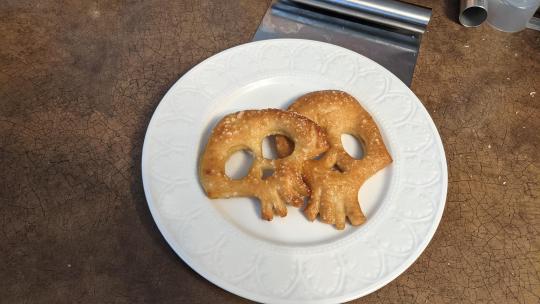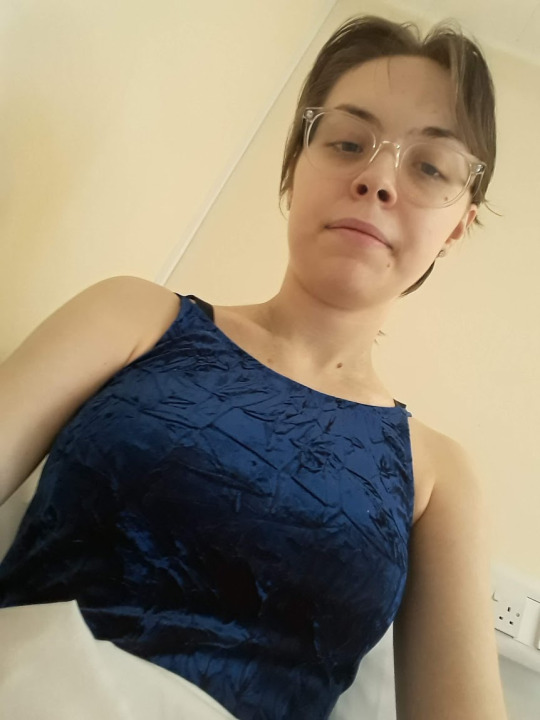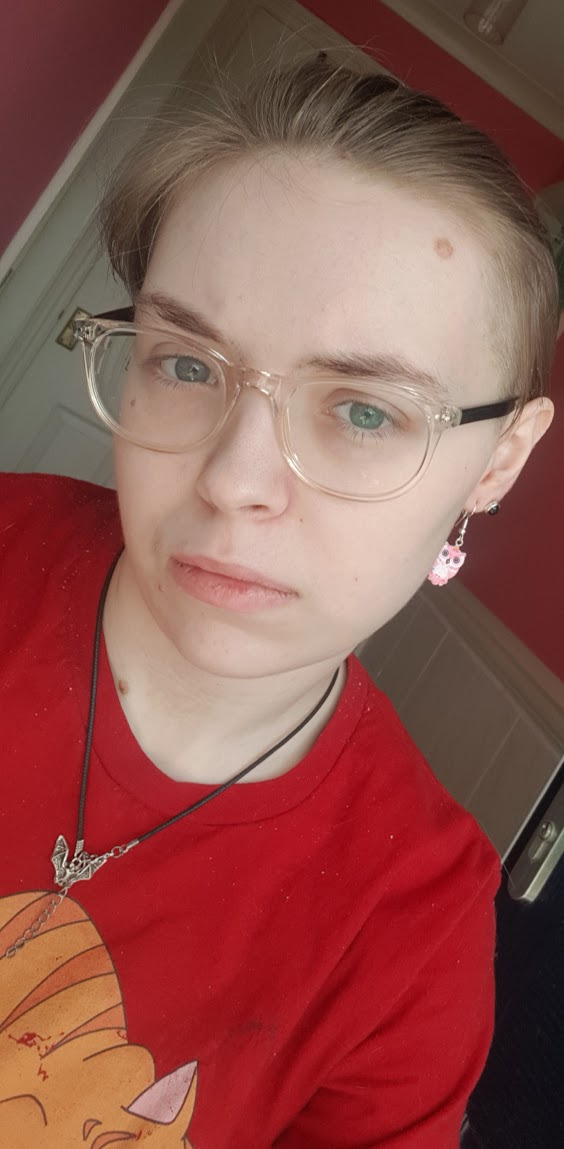#Chronic inflammatory demyelinating polyneuropathy
Explore tagged Tumblr posts
Text
The worst part about being chronically ill/ living with a rare disease, is I have to explain that I’m not in class cause I had an episode, fell on the floor, then couldn’t get out of bed.
#chronically ill#chronic illness#rare disease#autoimmine disease#cidp#chronic inflammatory demyelinating polyneuropathy#chronic fatigue#chronic pain#rare disorder#physically disabled#disabilties#disabled
33 notes
·
View notes
Text
CJ is sick...my immune system has declared war...shots have been fired...steroids are being deployed... wie ein Modder- Igel fühlen
Ich fühl mich wie gematschte Bananen
Ich fühl mich scheiße

And gifts for my German besties for accurate descriptions of how I feel @saltysupercomputer @dreaminggoblin @writingmaidenwarrior
And I'm not contagious, so they're safe

#chronic condition#autoimmine disease#Chronic inflammatory demyelinating polyneuropathy#chronic pain#chronic illness#i hate my immune system#CJ is sickly#writeblr#writeblr community#writeblr connect
25 notes
·
View notes
Text
God, what a journey. I have CIDP.



On the 8th of May I was told that my official diagnosis is 'CIDP' (Chronic Inflammatory Demyelinating Polyneuropathy) I have gone from the introverted but all-out goth willing to wear that blue dress into a hospital (first pic) to (with a fresh haircut) the dying to be out of the house, sill goth, geek (last pic)
I say this not to beg for sympathy but to say I'm officially disabled and finally at a comfortable point to say that, I am weird, I am Autistic, and I'm practically wheelchair-bound.
I am a rare case, most CIDP cases aren't in their early 20s with no prior illnesses before this happens to them, but I am lucky enough to live in the UK and have free healthcare, I can complain about wait times in A&E, or the slow way hospitals communicate, but I'm writing this to say that you should look out for yourself, cause you never know what will happen.
#my face#i am disabled#chronic illness#cidp#immune system#Chronic Inflammatory Demyelinating Polyneuropathy
4 notes
·
View notes
Text
hey cidp gang. my dad was officially diagnosed after suspecting for several years just a few months ago and is having a really hard time with coming to terms with needing a mobility aid.
what would you suggest for easing someone into using a mobility aid? as someone else with autoimmune issues i use braces galore but i dont feel weird about using them because i know they help me to like. literally walk. so i dont exactly know where he's coming from here. any advice?
3 notes
·
View notes
Text
A Kinda Ramble About Health
Sorry for not posting for a few days. I have been struggling with my immune condition a lot recently. I've been getting really bad tremors in my hands, and loss of motor function, and temporary paralysis in my right hand (probably from overuse / note taking). I have a hard time writing and typing. I'm working on getting appointments set up with my doctors, but it's a week before finals and my neurologist is 2 hours away. Does anyone who has CIDP have any advice?
0 notes
Text
Autoimmune - 4








#cam.txt#anti endo#anti endo userboxes#anti endogenic#disabled system#system punk#system userbox#system boxes#this system#sys blog#system blog#userbox blog#disabled sysboxes#gbs#guillain barre syndrome#cidp#chronic inflammatory demyelinating polyneuropathy#ms#multiple sclerosis#autoimmune#autoimmine disease#autoimmunities#autoimmunity
0 notes
Text
The CDC has quietly changed who should AVOID the MMR vaccine.
https://www.cdc.gov/vaccines/vpd/mmr/public/index.html
They now state that ANYONE that “Has a parent, brother or sister with a history of immune system problems” should AVOID THE MMR VACCINE!
What exactly is an 'immune system problem?" Every autoimmune disorder.
* Achalasia
* Addison’s disease
* Adult Still's disease
* Agammaglobulinemia
* Alopecia areata
* Amyloidosis
* Amyotrophic lateral sclerosis (Lou Gehrigs)
* Ankylosing spondylitis
* Anti-GBM/Anti-TBM nephritis
* Antiphospholipid syndrome
* Autoimmune angioedema
* Autoimmune dysautonomia
* Autoimmune encephalomyelitis
* Autoimmune hepatitis
* Autoimmune inner ear disease (AIED)
* Autoimmune myocarditis
* Autoimmune oophoritis
* Autoimmune orchitis
* Autoimmune pancreatitis
* Autoimmune retinopathy
* Autoimmune urticaria
* Axonal & neuronal neuropathy (AMAN)
* Baló disease
* Behcet’s disease
* Benign mucosal pemphigoid
* Bullous pemphigoid
* Castleman disease (CD)
* Celiac disease
* Chagas disease
* Chronic inflammatory demyelinating polyneuropathy (CIDP)
* Chronic recurrent multifocal osteomyelitis (CRMO)
* Churg-Strauss Syndrome (CSS) or Eosinophilic Granulomatosis (EGPA)
* Cicatricial pemphigoid
* Cogan’s syndrome
* Cold agglutinin disease
* Congenital heart block
* Coxsackie myocarditis
* CREST syndrome
* Crohn’s disease
* Dermatitis herpetiformis
* Dermatomyositis
* Devic’s disease (neuromyelitis optica)
* Discoid lupus
* Dressler’s syndrome
* Endometriosis
* Eosinophilic esophagitis (EoE)
* Eosinophilic fasciitis
* Erythema nodosum
* Essential mixed cryoglobulinemia
* Evans syndrome
* Fibromyalgia
* Fibrosing alveolitis
* Giant cell arteritis (temporal arteritis)
* Giant cell myocarditis
* Glomerulonephritis
* Goodpasture’s syndrome
* Granulomatosis with Polyangiitis
* Graves’ disease
* Guillain-Barre syndrome
* Hashimoto’s thyroiditis
* Hemolytic anemia
* Henoch-Schonlein purpura (HSP)
* Herpes gestationis or pemphigoid gestationis (PG)
* Hidradenitis Suppurativa (HS) (Acne Inversa)
* Hypogammalglobulinemia
* IgA Nephropathy
* IgG4-related sclerosing disease
* Immune thrombocytopenic purpura (ITP)
* Inclusion body myositis (IBM)
* Interstitial cystitis (IC)
* Juvenile arthritis
* Juvenile diabetes (Type 1 diabetes)
* Juvenile myositis (JM)
* Kawasaki disease
* Lambert-Eaton syndrome
* Leukocytoclastic vasculitis
* Lichen planus
* Lichen sclerosus
* Ligneous conjunctivitis
* Linear IgA disease (LAD)
* Lupus
* Lyme disease chronic
* Meniere’s disease
* Microscopic polyangiitis (MPA)
* Mixed connective tissue disease (MCTD)
* Mooren’s ulcer
* Mucha-Habermann disease
* Multifocal Motor Neuropathy (MMN) or MMNCB
* Multiple sclerosis
* Myasthenia gravis
* Myositis
* Narcolepsy
* Neonatal Lupus
* Neuromyelitis optica
* Neutropenia
* Ocular cicatricial pemphigoid
* Optic neuritis
* Palindromic rheumatism (PR)
* PANDAS
* Parkinson's disease
* Paraneoplastic cerebellar degeneration (PCD)
* Paroxysmal nocturnal hemoglobinuria (PNH)
* Parry Romberg syndrome
* Pars planitis (peripheral uveitis)
* Parsonage-Turner syndrome
* Pemphigus
* Peripheral neuropathy
* Perivenous encephalomyelitis
* Pernicious anemia (PA)
* POEMS syndrome
* Polyarteritis nodosa
* Polyglandular syndromes type I, II, III
* Polymyalgia rheumatica
* Polymyositis
* Postmyocardial infarction syndrome
* Postpericardiotomy syndrome
* Primary biliary cirrhosis
* Primary sclerosing cholangitis
* Progesterone dermatitis
* Psoriasis
* Psoriatic arthritis
* Pure red cell aplasia (PRCA)
* Pyoderma gangrenosum
* Raynaud’s phenomenon
* Reactive Arthritis
* Reflex sympathetic dystrophy
* Relapsing polychondritis
* Restless legs syndrome (RLS)
* Retroperitoneal fibrosis
* Rheumatic fever
* Rheumatoid arthritis
* Sarcoidosis
* Schmidt syndrome
* Scleritis
* Scleroderma
* Sjögren’s syndrome
* Sperm & testicular autoimmunity
* Stiff person syndrome (SPS)
* Subacute bacterial endocarditis (SBE)
* Susac’s syndrome
* Sympathetic ophthalmia (SO)
* Takayasu’s arteritis
* Temporal arteritis/Giant cell arteritis
* Thrombocytopenic purpura (TTP)
* Tolosa-Hunt syndrome (THS)
* Transverse myelitis
* Type 1 diabetes
* Ulcerative colitis (UC)
* Undifferentiated connective tissue disease (UCTD)
* Uveitis
* Vasculitis
* Vitiligo
* Vogt-Koyanagi-Harada Disease
Wonder how many doctors are paying attention?
~shared from Jodi Wilson
31 notes
·
View notes
Text
What's fucked up is that my nerve disorder pills for the pain in my feet have to be taken with food but when I wake up in the morning my feet hurt enough that I don't want to walk on them into the kitchen to make food to take the feet-pain-fixing pills
#fighting words#autoimmune disorder#autoimmune disease#nerve pain#nerve damage#nerve disorder#cidp#chronic inflammatory demyelinating polyneuropathy
1 note
·
View note
Link
0 notes
Text
0 notes
Text
Intravenous Immunoglobulin (IVIG) Market: $16.3B in 2023 to $31.2B by 2033, 6.8% CAGR
Intravenous Immunoglobulin (IVIG) market is experiencing notable growth, driven by the increasing prevalence of immune deficiencies and autoimmune disorders, alongside advancements in plasma-derived therapies and immunotherapy. IVIG therapies are widely used to treat a variety of conditions, including primary immunodeficiency, autoimmune diseases, and neurological disorders. As the global demand for these treatments rises, the market is witnessing significant advancements in production technologies, regulatory improvements, and strategic collaborations.
To Request Sample Report: https://www.globalinsightservices.com/request-sample/?id=GIS25768 &utm_source=SnehaPatil&utm_medium=Article
The primary immunodeficiency segment holds the largest market share, accounting for 45%, due to the increasing diagnosis rates and a greater focus on early intervention. Autoimmune diseases, particularly chronic inflammatory demyelinating polyneuropathy (CIDP), follow with a strong market presence at 30%, reflecting the growing awareness and better diagnostic capabilities for these disorders. Immune thrombocytopenic purpura (ITP) comes in third at 25%, a significant driver of IVIG usage. The availability of both liquid and lyophilized IVIG forms offers flexibility in treatment and broader market access.
North America remains the leading region for IVIG therapies, primarily driven by its advanced healthcare infrastructure, high adoption of immunotherapy, and significant research activities. The United States is the key player in this market, benefiting from substantial healthcare expenditure and the presence of major pharmaceutical companies like Grifols, CSL Behring, and Octapharma, which contribute to ongoing research and technological innovations. Europe follows as the second-largest market, where supportive government policies and a growing geriatric population drive the demand for IVIG treatments. Germany, France, and the United Kingdom are major contributors to the European market, supported by their strong pharmaceutical industries and expanding patient pools.
The IVIG market is also seeing a surge in R&D investments, with projections of a 10% annual increase, driven by the need for novel therapeutic applications and improved patient outcomes. Advancements in recombinant DNA technology, chromatography, and personalized medicine are expected to revolutionize treatment options, further fueling market growth.
Despite the optimistic growth outlook, challenges such as supply chain disruptions and pricing pressures persist. However, market players are adapting with strategic collaborations, improving manufacturing capabilities, and expanding their geographic reach to meet growing global demand.
#IVIG #Immunotherapy #PlasmaTherapy #Immunodeficiency #AutoimmuneDiseases #PrimaryImmunodeficiency #ChronicInflammatoryDemyelinatingPolyneuropathy #Grifols #CSLBehring #Octapharma #Immunoglobulin #HealthInnovation #BiotechAdvancements #GlobalHealth #PersonalizedMedicin
0 notes
Text
This probably makes me sound like a brat, but I really wish I had the opportunity to go to the Eras Tour again. Of course I’m so grateful that I even got to go once, but when I went in 2023 I was really struggling with my chronic illness and had to spend the concert in a wheelchair. I had just gotten out of the hospital a week before, so I was still learning how to navigate life with a disability. It was an overall very stressful experience for me. I’m now walking again and can’t help but want to see the show again.
#taylor swift#the eras tour#taylor swift the eras tour#taylor nation#the tortured poets department#chronic illness#disability#disability awareness#disabled#chronically ill#chronic illness awareness#autoimmine disease#nerve damage#chronic inflammatory demyelinating polyneuropathy#disabilties#physically disabled#physical disability#swifties#ts the eras tour
6 notes
·
View notes
Text

This is the first time that the name of a bot has made me legit laugh out loud and HARD. I have an autoimmune condition known as chronic inflammatory demyelinating polyneuropathy - basically my immune system destroys the proteins around my nerves and causes extremely painful peripheral neuropathy. So The idea of an Overpowering Nerve following me?! NOPE! FUCK NOPE! Fuck straight off... *dies laughing*
2 notes
·
View notes
Text
Plasma Fractionation Market: Technological Advancements, Market Size, and Forecast
The global plasma fractionation market size is estimated to reach USD 58.24 billion by 2030, registering to grow at a CAGR of 8.5% from 2025 to 2030 according to a new report by Grand View Research, Inc. The major factors driving the market growth are the rising prevalence of respiratory illnesses globally, blood-related diseases, and an aging population that is prone to a variety of rare disorders. These are the main drivers of market expansion. In addition, the rise in the prevalence of rare disorders that call for plasma therapy or derivatives also supplemented the market growth.
The global market is also expanding due to the increased use of immunoglobulins as well as alpha-1-antitrypsin in various areas of research around the world. Another important factor for the expansion of the market is the rise in blood collection facilities globally. For instance, as per the WHO, as of May 2022, over 118 million blood donations were collected across the globe, thus increasing the plasma supply gradually. Additionally, supportive government initiatives to raise public awareness about the usage of plasma-derived products also serve as a major driver of the global market's expansion.
Blood plasma transfusions are one of the cutting-edge treatments for COVID-19 infection. For instance, in August 2020, the US Food and Drug Administration (USFDA) granted the convalescent plasma treatment of COVID-19 an emergency use authorization (EUA). Additionally, in February 2021, it published an amended directive for the plasma EUA for COVID-19. As a result, the usage of plasma fractionation technologies is projected to increase during the COVID-19 pandemic.
The growing demand for personalized medications has increased R&D spending, and technological advancements in plasma components such as immune serum globulin, which have advantages such as higher yield, lower cost, and faster throughput, are driving market growth. On the other hand, immunoglobulins generated from plasma are being employed more frequently for a variety of clinical conditions, including autoimmune and inflammatory illnesses. Therapies including Ceruloplasmin, IgA, and Plasmin have received significant funding from the plasma fractionation sector. Additionally, the industry will receive a boost from booming investments in innovation and technology developments that result in efficient and affordable methods for fractionating proteins. thus, propelling the market's growth.
For companies operating market-related businesses, the market offers a lot of opportunities. In addition, the global and regional market participants are actively implementing organic and inorganic development strategies as a result of the market's favorable expansion. As a result, it is anticipated that the market will draw more notable investments during the forecast period. For instance, in January 2022, the eighth plasma collection facility in the Czech Republic was opened by Biotest AG. The national public health authority, SUKL, granted the company an operating license for these centers.
Plasma Fractionation Market Report Highlights
The immunoglobulins segment dominated the market in terms of revenue share of 63.2% in 2024 and is anticipated to grow at the fastest CAGR of 9.1%. fueled by its widespread use in treating immune deficiencies, autoimmune diseases, and neurological disorders.
The chromatography segment dominated the market and accounted for a 33.7% share in 2024. The utilization of industrial-scale chromatographic fractionation as well as purification techniques for plasma fractionation has increased recently.
The neurology segment held the largest revenue share of 30.0% in 2024, driven by the increasing recognition of plasma-derived therapies for neurological disorders. Conditions such as multiple sclerosis, Guillain-Barré syndrome, and chronic inflammatory demyelinating polyneuropathy are increasingly being treated with therapies like intravenous immunoglobulin (IVIg) and plasmapheresis.
The hospitals and clinics dominated the market with the largest revenue share of 53.4% in 2024 and are expected to grow at the fastest CAGR of 9.0% over the forecast period. This is driven by the increasing demand for plasma-derived therapies in various medical applications.
Plasma Fractionation Market Segmentation
Grand View Research has segmented the global plasma fractionation market based on product, method, application, end-use, and region:
Plasma Fractionation Product Outlook (Revenue, USD Billion, 2018 - 2030)
Albumin
Immunoglobulins
Intravenous immunoglobulins
Subcutaneous immunoglobulins
Other immunoglobulins
Coagulation Factors
Factor VIII
Factor IX
VON WILLEBRAND factor
Prothrombin complex concentrates
Fibrinogen concentrates
Others
Protease inhibitors
Others
Plasma Fractionation Method Outlook (Revenue, USD Billion, 2018 - 2030)
Centrifugation
Depth Filtration
Chromatography
Others
Plasma Fractionation Application Outlook (Revenue, USD Billion, 2018 - 2030)
Neurology
Hematology
Oncology
Immunology
Pulmonology
Others
Plasma Fractionation End-use Outlook (Revenue, USD Billion, 2018 - 2030)
Hospitals & Clinics
Clinical Research
Others
Plasma Fractionation Regional Outlook (Revenue, USD Billion, 2018 - 2030)
North America
US
Canada
Mexico
Europe
UK
Germany
France
Italy
Spain
Denmark
Sweden
Norway
Asia Pacific
Japan
China
India
Australia
South Korea
Thailand
Latin America
Brazil
Argentina
MEA
South Africa
Saudi Arabia
UAE
Kuwait
List of Key Players in the Plasma Fractionation Market
Grifols S.A.
CSL Limited
Takeda Pharmaceutical Company Limited
Octapharma AG
Kedrion S.p.A
LFB S.A.
Biotest AG
Sanquin
Bio Products Laboratory Ltd.
Intas Pharmaceuticals Ltd
Order a free sample PDF of the Plasma Fractionation Market Intelligence Study, published by Grand View Research.
0 notes
Text
0 notes
Text
Chronic Inflammatory Demyelinating Polyneuropathy
Progressive muscle weakness and loss of sensation in the extremities characterize CIDP, or Chronic Inflammatory Demyelinating Polyneuropathy, a neurological disorder. An autoimmune condition, CIDP means the body’s immune system mistakenly attacks its own nerves. Key features of CIDP: Progressive muscle weakness: This often begins in the feet and legs but can spread to the hands and arms over…
0 notes